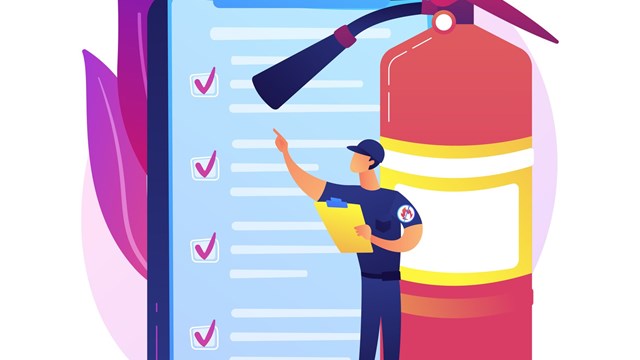New York City's building code is a complex set of documents, regulations, amendments, "letters," and local laws regulating every aspect of building construction and maintenance from window specifications, boiler maintenance, elevators, exterior walls, and even paint - it's a massive body of material that more often than not takes an expert to interpret.
"The current New York City Building Code was enacted in 1968, and is one of the most stringent codes in the country," says Jennifer Givner, a spokesperson for the New York City Department of Buildings (DOB). "It's also considered one of the most convoluted." And Givner should know, because it's the DOB that has the authority to enforce and interpret the code as it applies directly to the city's residential buildings. The 2003 edition of the code, which is basically an administrative update of all local laws and regulations that have passed since 1968, was released to the public earlier this year.
According to architect Richard Ferrara of the Brooklyn firm of Delacour and Ferrara, New York City is the proving ground for building regulations that may be put to use in less densely populated parts of the state. "Even state [building] laws go through the city," says Ferrara. "It's true of every city that has more than a certain level of population."
But it's actually even more complicated than that, Ferrara continues. Some areas concerning minor alterations might actually be grandfathered in and go according to the old 1938 building code, he says.
Currently, New York City is trying to adopt yet another code - the International Building Code, or IBC - with modifications tailored to New York City. But more about that later.
Even before there was a standardized code, the city has always had building regulations, going back to the days of the Dutch. By 1674, according to Givner, "Extensive laws governing construction, fire prevention and sanitation were in place." In 1850, the first comprehensive building code in the country was enacted in New York.
Historically, building laws have often been passed after problems have come to the public's attention. For example, the city's building laws were extensively revised after a fatal tenement fire in 1860. Throughout the 19th century, reformers like Jacob Riis were exposing the abominable conditions in Manhattan's tenements. One response to this was the "New Law" tenement act of 1901, which mandated more light and air be let into the city's dark, claustrophobic tenement buildings.
Even recently, accidents often lead to changes to the code. For example, Local Law 10 of 1980 requires that owners file inspection reports - prepared by architects or engineers - every five years for exterior walls that face sidewalks, roads or streets. The law was spurred in part by a tragic accident involving a female Columbia student who was hit by falling debris from the front of a building.
Still, says Joseph Smizanski, director of operations for Rosenwach Tank Co., a Long Island City-based construction and restoration company, "Stuff started falling from the backs of buildings and from terraces, so the city decided with Local Law 11 [of 1998], that all exterior walls had to be inspected." Walls that are less than 12 inches from an adjacent building are exempted.
Of course, the World Trade Center disaster has also brought about changes in the Building Code. Local Law 26 was passed in 2004 in response to 9/11, to increase buildings' ability to evacuate in the event of a catastrophe. The law is extremely detailed, addressing sprinklers, exit signs, and emergency action plans. Most provisions, however, deal with office, commercial or institutional buildings.
Disasters aren't the only impetus to amending the code - it is also amended as new technology emerges and as the city changes. For example, says Givner, seismic regulations were adopted for new construction in the 1990s after the federal government upgraded the city's status as earthquake-prone. And, in a well-known example from this past year, carbon monoxide detectors were mandated in residential buildings after affordable, reliable technology was developed to save lives.
Code amendments can be introduced either by the Mayor's Office or the City Council. Proposals to change the building code are reviewed by the council's Committee on Housing and Buildings, and public hearings must be scheduled. As in all New York City municipal bills, once a bill passes the full council, it is sent to the mayor for his approval - or veto.
Of course, the input of those in the building industry - developers, architects, contractors - has to be considered as well, and industry professionals can voice their opinions through a number of channels, like the city council or other legislative bodies.
Smizanski says that earlier this year, contractors got together to campaign for a change in the way that scaffolds are permitted. "Everyone wrote in, saying [the process] was taking too long," he says. "There's a whole political network, but it's not easy."
According to the Buildings Department, New York City is now in the process of trying to adopt the IBC. The IBC is a part of the ICC's "I-Codes;" a series of model codes that are currently used by more than 47 states.
Several years ago, says Michael Clemens, regional manager for government relations of the ICC, "Mayor Bloomberg appointed a commission to study the IBC and another document, the National Fire Protection Association (NFPA) code, to see which of the two codes they would recommend. The mayor and the commission said they wanted the IBC."
Now, 400 professionals, organized into 13 technical committees and a managing committee, are studying the issues surrounding the adoption of the IBC in NYC and making recommendations. "The key thing to remember about this process," says Givner, "is that New York City is a high-density urban environment, so the Model Code Program is not going to adopt the IBC as is. We will adopt the IBC and its framework with New York city-specific standards."
This year, at the request of Mayor Bloomberg, several City Council members have introduced Intro. No. 478, the "blueprint bill," which provides for "a modern construction code or codes based on the national model construction codes developed by the International Code Council to replace the city's outdated building code."
However, adds Clemens, the NFPA code still has its supporters, including some unions. Another group of council members has introduced Intro. No. 368, which would have the city adopt "The 2003 edition of the National Fire Protection Association Building Construction and Safety Code "¦ to replace the current Building Code of the city of New York."
On November 30th of this year, the City Council conducted the first of several scheduled full public hearings to discuss the proposed code overhaul. Hundreds of contractors showed up to say their piece and debate the merits of the IBC versus the newer code proposed by the NFPA.
With all the regulations on the books, which are most applicable to, and have the most impact on, co-ops and condos? Smizanski names the aforementioned Local Laws 10 and 11 that deal with buildings' exteriors. "People used to let the buildings go for years. Now, there's more of a cost for maintaining residential buildings, but it saves money in the long run - the owners don't let them go downhill."
Howard I. Zimmerman of Howard I. Zimmerman Architects in Manhattan also mentions Local Laws 10 and 11, but also cites Local Law 16, which mandates "You Are Here" signs in the vicinity of the elevator to show the location of the stairwells in case of fire. Ferrara cites Local Law 58 of 1987, mandating compliance with the federal Americans with Disabilities Act (ADA). This, he says, comes into play when a building is being renovated. Owners can get a waiver if the work is too expensive - for example, if making an old five-story walk-up ADA-compliant would cost as much as the building itself.
Today, the city's building code is enforced by the Department of Buildings. The DOB does administer some violations, says Givner - Local Law 62 involving boilers, for example - while others, mostly in the category of hazardous or non-hazardous, are heard before the Environmental Control Board, a civil agency within the Department of Environmental Protection (DEP).
Violations, according to DOB, do not automatically result in a penalty - there is a 35-day grace period when the respondent may correct the condition without a penalty. For first-time violations, typical fines can range between several hundred dollars and $3,500.
Ferrara gives an example. "If a condo or co-op has one boiler for more than five or six families, they have to have it inspected every year, and the inspection has to be filed with the Department of Buildings. If you don't do that, the violation is roughly $500 - and you still have to have the inspection done."
Quite a few resources exist to help co-op and condo boards, managers and contractors understand and abide by the code. The Department of Building's website (www.nyc.gov/html/dob/home. html) has a vast amount of information, particularly under links to Publications and Resources. The DOB also has monthly technical forums for architects, engineers and building owners.
"A lot of co-ops and boards - especially ones with many units - have a kind of house architect with whom they consult about what residents want to build," says Ferrara.
"The Internet is the biggest resource," adds Smizanski.
Zimmerman concurs about the resourcefulness of the Internet and says that co-ops and condos can keep up with regulations by working closely with engineers and architects.
The fact remains that New York City's building code is a rather complicated, sometimes Byzantine set of documents, but thankfully, the right guidance and professional advice can help your building navigate it. If you want to see the latest version of the code itself, it's available by purchase at the City Store (http://www/nyc/gov/hteml/citystore). It is also available for viewing on the DOB's website at www.nyc.gov/html/code.html.







Comments
Leave a Comment